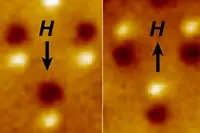 Engineers at the University of California, Berkeley (UC Berkeley), claim to have shown for the first time that magnetic chips can operate with the lowest fundamental level of energy dissipation possible under the laws of thermodynamics. This means that dramatic reductions in power consumption are possible - as much as one-millionth the amount of energy per operation used by transistors in modern computers.
Engineers at the University of California, Berkeley (UC Berkeley), claim to have shown for the first time that magnetic chips can operate with the lowest fundamental level of energy dissipation possible under the laws of thermodynamics. This means that dramatic reductions in power consumption are possible - as much as one-millionth the amount of energy per operation used by transistors in modern computers.
"We wanted to know how small we could shrink the amount of energy needed for computing," said Jeffrey Bokor, professor of electrical engineering and computer sciences at UC Berkeley. "The biggest challenge in designing computers and, in fact, all our electronics today is reducing their energy consumption."
Lowering energy use is a relatively recent shift in focus in chip manufacturing after decades of emphasis on packing greater numbers of smaller and faster transistors onto chips.
"Making transistors go faster was requiring too much energy," Prof Bokor continued. "The chips were getting so hot they'd just melt."
The engineers say that magnetic computing has emerged as a promising alternative to conventional transistors because the magnetic bits can be differentiated by direction, and it takes just as much energy to get the magnet to point left as it does to point right.
The UC Berkeley team used an innovative technique to measure the tiny amount of energy dissipation that resulted when they flipped a nanomagnetic bit. They used a laser probe to follow the direction that the magnet was pointing as an external magnetic field was used to rotate the magnet from ‘up’ to ‘down’ or vice versa.
They determined that it took 15meV (millielectron volts) of energy to flip a magnetic bit at room temperature. This is said to be the first time that a practical memory bit has been manipulated and observed under conditions that would allow the Landauer limit to be reached, the researchers said.
While this is a proof of principle, Prof Bokor noted that putting such chips into practical production will take more time. But the researchers noted that "the significance of this result is that today's computers are far from the fundamental limit and that future dramatic reductions in power consumption are possible."
Pic: Magnetic microscope image of three nanomagnetic computer bits. Each is a tiny bar magnet 90nm long. The image shows a bright spot at the 'North' end & a dark spot at the 'South' end of the magnet. The 'H' arrow shows the direction of the magnetic field
Author
Tom Austin-Morgan
Source: www.newelectronics.co.uk

